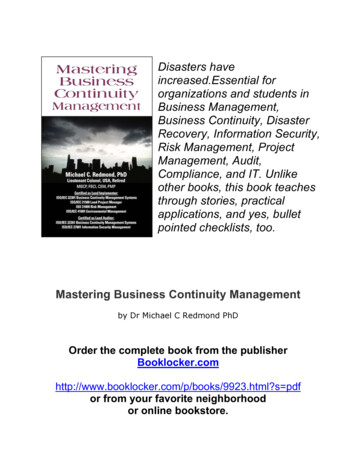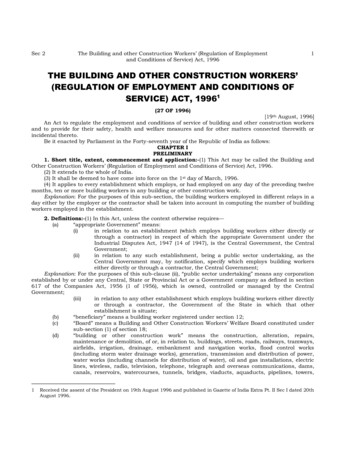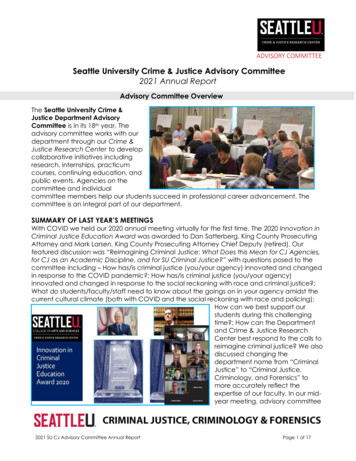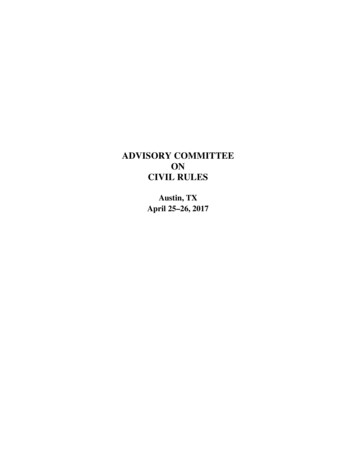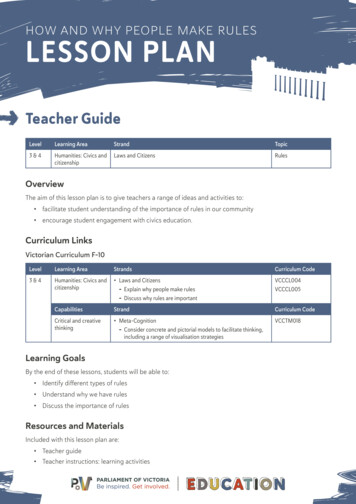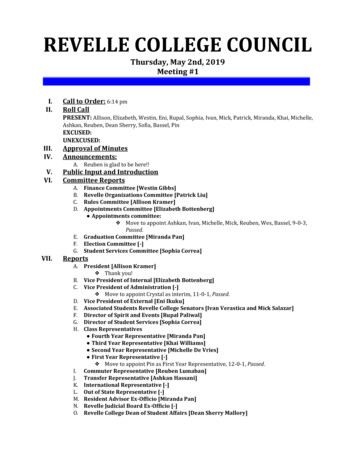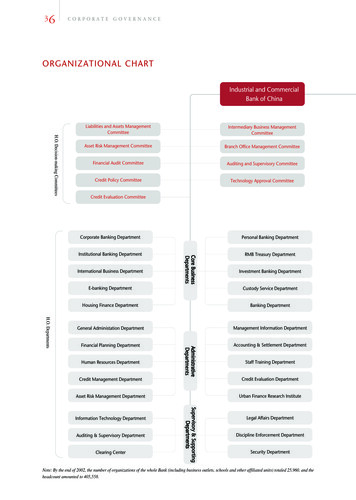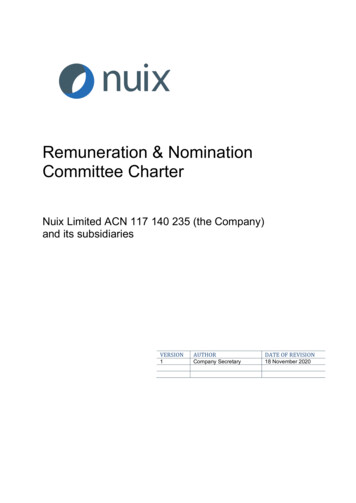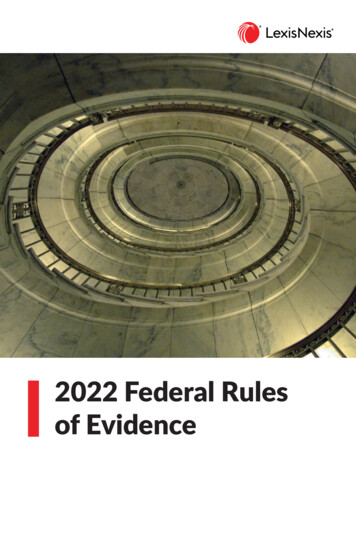
Transcription
ADVISORY COMMITTEEONEVIDENCE RULESPortland, MEOctober 11, 2013
TABLE OF CONTENTSAGENDA . 5TAB 1TAB 2TAB 3OPENING BUSINESSA.Draft Minutes of May 2013 Meeting of the Evidence RulesCommittee . 19B.Draft Minutes of June 2013 Meeting of the Standing Committee . 37PROPOSED AMENDMENTS APPROVED BY THE JUDICIAL CONFERENCEOF THE UNITED STATESA.Rule 801(d)(1)(B). 43B.Rule 803(6) . 49C.Rule 803(7) . 55D.Rule 803(8) . 59POSSIBLE AMENDMENT OF RULE 803(16)Reporter’s Memorandum Regarding Hearsay Exception for AncientDocuments and its Applicability to ESI (September 15, 2013) . 65TAB 4EFFECT OF CM/ECF ON RULES OF EVIDENCEReporter’s Memorandum Regarding Amendment of Evidence Rulesto Accommodate CM/ECF (July 1, 2013) . 77TAB 5CRAWFORD V. WASHINGTON & WILLIAMS V. ILLINOISReporter’s Memorandum Regarding Federal Case Law DevelopmentAfter Crawford v. Washington — and After the Confusion ofWilliams v. Illinois (September 1, 2013) . 95October 11, 2013Page 3 of 208
THIS PAGE INTENTIONALLY BLANKOctober 11, 2013Page 4 of 208
ADVISORY COMMITTEE ON EVIDENCE RULESAGENDA FOR COMMITTEE MEETINGPortland, MaineOctober 11, 2013I. Opening BusinessOpening business includes:! Approval of the minutes of the Spring, 2013 meeting;! A report on the June, 2013 meeting of the Standing Committee;! A welcome to a new member, Judge Livingston;! An expression of thanks and gratitude to departing member Judge Brody; and! A discussion about the Symposium on electronic evidence, taking place on the morningof the Committee meeting.II. Proposed Amendments to Rule 801(d)(1)(B) and Rules 803(6)-(8)The proposed amendments to Rule 801(d)(1)(B) and to Rules 803(6), (7), and (8) wereapproved by the Standing Committee and referred to the Judicial Conference. Barring anyunforeseen developments, these amendments will become effective on December 1, 2014. Theagenda book sets forth the rules and notes as they were approved by the Judicial Conference.III. Possible Amendment to Rule 803(16)The agenda book contains a memo on consideration of a possible amendment to Rule803(16), the hearsay exception for ancient documents. The question addressed is whether theexception needs to be altered or abrogated in light of the fact that electronically stored informationis widespread, does not degrade, and can be fairly easily stored for 20 years.1October 11, 2013Page 5 of 208
IV. Review of Effect of CM/ECF on Evidence RulesA Subcommittee of the Standing Committee is investigating to what extent the national rulesof procedure should be amended to accommodate electronic case filing and case management. TheReporter prepared a report to the Subcommittee on whether changes to the Evidence Rules mightbe necessary because of cm/ecf. That memo is set forth in the agenda book for the Committee’sinformation.V. Crawford OutlineThe agenda book contains the Reporter’s updated outline on cases applying the SupremeCourt’s Confrontation Clause jurisprudence.VI. Privilege ProjectProfessor Broun will provide an oral report on his project surveying the law of privilege.2October 11, 2013Page 6 of 208
ADVISORY COMMITTEE ON EVIDENCE RULESChair, Advisory Committeeon Evidence RulesHonorable Sidney A. FitzwaterChief JudgeUnited States District CourtEarle Cabell Federal Bldg. and U.S. Courthouse1100 Commerce Street, Room 1528Dallas, TX 75242-1310Reporter, Advisory Committeeon Evidence RulesProfessor Daniel J. CapraFordham University School of Law140 West 62nd StreetNew York, NY 10023Members, Advisory Committeeon Evidence RulesHonorable Brent R. AppelIowa Supreme CourtIowa Judicial Branch Building1111 East Court AvenueDes Moines, IA 50319Edward C. DuMont, Esq.WilmerHale1875 Pennsylvania Avenue, NWWashington, DC 20006Honorable Stuart M. GoldbergPrincipal Associate Deputy Attorney General(ex officio)United States Department of Justice950 Pennsylvania Avenue, N.W. – Room 4208Washington, DC 20530A.J. Kramer, Esq.Federal Public DefenderIndiana Plaza625 Indiana Avenue, N.W. – Suite 550Washington, DC 20004Honorable Debra Ann LivingstonUnited States Court of AppealsThurgood Marshall United States Courthouse40 Centre Street, Room 2303New York, NY 10007-1501October 11, 2013Page 7 of 208
Members, Advisory Committeeon Evidence Rules (cont’d.)Honorable William K. Sessions IIIUnited States District CourtFederal Building11 Elmwood Avenue, 5th FloorBurlington, VT 05401Paul Shechtman, Esq.Zuckerman Spaeder LLP1185 Avenue of the Americas, 31st FloorNew York, NY 10036Honorable John A. Woodcock, Jr.Chief JudgeUnited States District CourtMargaret Chase Smith Federal Building202 Harlow Street, 3rd FloorBangor, ME 04401-4901Consultant, Advisory Committee onEvidence RulesProfessor Kenneth S. BrounUniversity of North Carolina School of LawCB #3380, Van Hecke-Wettach HallChapel Hill, NC 27599Liaison Members, Advisory Committeeon Evidence RulesHonorable Paul S. Diamond(Civil)United States District CourtJames A. Byrne United States Courthouse601 Market Street, Room 6613Philadelphia, PA 19106Honorable John F. Keenan(Criminal)United States District Court1930 Daniel Patrick Moynihan U.S. Courthouse500 Pearl StreetNew York, NY 10007-1312Honorable Richard C. Wesley (Standing)United States Court of AppealsLivingston County Government CenterSix Court StreetGeneseo, NY 14454-1043October 11, 2013Page 8 of 208
Liaison Members, Advisory Committeeon Evidence Rules (cont’d.)Honorable Judith H. Wizmur (Bankruptcy)Chief JudgeUnited States Bankruptcy CourtMitchell H. Cohen U.S. Courthouse2nd Floor – 400 Cooper StreetCamden, NJ 08102-1570Secretary, Standing Committeeand Rules Committee OfficerJonathan C. RoseSecretary, Committee on Rules of Practice &Procedure and Rules Committee OfficerThurgood Marshall Federal Judiciary BuildingOne Columbus Circle, N.E., Room 7-240Washington, DC 20544Phone 202-502-1820Fax202-502-1755Jonathan Rose@ao.uscourts.govChief CounselAndrea L. KupermanChief Counsel to the Rules Committees11535 Bob Casey U.S. Courthouse515 Rusk Ave.Houston, TX 77002-2600Phone 713-250-5980Fax713-250-5213Andrea Kuperman@txs.uscourts.govDeputy Rules Committee Officerand CounselBenjamin J. RobinsonDeputy Rules Committee Officerand Counsel to the Rules CommitteesThurgood Marshall Federal Judiciary BuildingOne Columbus Circle, N.E., Room 7-240Washington, DC 20544Phone 202-502-1516Fax202-502-1755Benjamin Robinson@ao.uscourts.govOctober 11, 2013Page 9 of 208
LIAISON MEMBERSLiaison for the Advisory Committeeon Appellate RulesGregory G. Garre, Esq.(Standing)Liaison for the Advisory Committeeon Appellate RulesJudge Adalberto Jordan(Bankruptcy)Liaison for the Advisory Committeeon Bankruptcy RulesRoy T. Englert, Jr., Esq.(Standing)Liaison for the Advisory Committeeon Civil RulesJudge Arthur I. Harris(Bankruptcy)Liaison for the Advisory Committeeon Civil RulesJudge Diane P. Wood(Standing)Liaison for the Advisory Committeeon Criminal RulesJudge Marilyn L. Huff(Standing)Liaison for the Advisory Committeeon Evidence RulesJudge Judith H. Wizmur(Bankruptcy)Liaison for the Advisory Committeeon Evidence RulesJudge Paul S. Diamond(Civil)Liaison for the Advisory Committeeon Evidence RulesJudge John F. Keenan(Criminal)Liaison for the Advisory Committeeon Evidence RulesJudge Richard C. Wesley(Standing)October 11, 2013Page 10 of 208
ADMINISTRATIVE OFFICE OF THE UNITED STATES COURTSJonathan C. RoseSecretary, Committee on Rules of Practice &Procedure and Rules Committee OfficerThurgood Marshall Federal Judiciary BuildingOne Columbus Circle, N.E., Room 7-240Washington, DC 20544Phone 202-502-1820Fax202-502-1755Jonathan Rose@ao.uscourts.govPeter G. McCabeAssistant DirectorOffice of Judges ProgramsThurgood Marshall Federal Judiciary BuildingOne Columbus Circle, N.E., Room 4-180Washington, DC 20544Phone 202-502-1800Fax202-502-1755peter mccabe@ao.uscourts.govBenjamin J. RobinsonDeputy Rules Committee Officerand Counsel to the Rules CommitteesThurgood Marshall Federal Judiciary BuildingOne Columbus Circle, N.E., Room 7-240Washington, DC 20544Phone 202-502-1516Fax202-502-1755Benjamin Robinson@ao.uscourts.govJulie WilsonAttorney AdvisorThurgood Marshall Federal Judiciary BuildingOne Columbus Circle, N.E., Room 4-250Washington, DC 20544Phone 202-502-3678Fax 202-502-1766Julie Wilson@ao.uscourts.govOctober 11, 2013Page 11 of 208
James H. Wannamaker IIISenior AttorneyBankruptcy Judges DivisionThurgood Marshall Federal Judiciary BuildingOne Columbus Circle, N.E., Room 4-254Washington, DC 20544Phone 202-502-1900Fax202-502-1988James Wannamaker@ao.uscourts.govScott MyersAttorney AdvisorBankruptcy Judges DivisionThurgood Marshall Federal Judiciary BuildingOne Columbus Circle, N.E., Room 4-250Washington, DC 20544Phone 202-502-1900Fax202-502-1988Scott Myers@ao.uscourts.govBridget M. HealyAttorney AdvisorBankruptcy Judges DivisionThurgood Marshall Federal Judiciary BuildingOne Columbus Circle, N.E., Room 4-273Washington, DC 20544Phone 202-502-1900Fax202-502-1988Bridget Healy@ao.uscourts.govFrances F. SkillmanParalegal SpecialistThurgood Marshall Federal Judiciary BuildingOne Columbus Circle, N.E., Room 7-240Washington, DC 20544Phone 202-502-3945Fax202-502-1755Frances Skillman@ao.uscourts.govOctober 11, 2013Page 12 of 208
FEDERAL JUDICIAL CENTERJoe Cecil(Rules of Practice & Procedure)Senior Research AssociateResearch DivisionThurgood Marshall Federal Judiciary BuildingOne Columbus Circle, N.E.Washington, DC 20002-8003Phone 202-502-4084Fax202-502-4199jcecil@fjc.govMarie Leary(Appellate Rules Committee)Research AssociateResearch DivisionThurgood Marshall Federal Judiciary BuildingOne Columbus Circle, N.E.Washington, DC 20002-8003Phone 202-502-4069Fax202-502-4199mleary@fjc.govMolly T. Johnson(Bankruptcy Rules Committee)Senior Research AssociateResearch DivisionThurgood Marshall Federal Judiciary BuildingOne Columbus Circle, N.E.Washington, DC 20002-8003Phone 315-824-4945mjohnson@fjc.govEmery G. Lee(Civil Rules Committee)Senior Research AssociateResearch DivisionThurgood Marshall Federal Judiciary BuildingOne Columbus Circle, N.E.Washington, DC 20002-8003Phone 202-502-4078Fax202-502-4199elee@fjc.govLaural L. Hooper(Criminal Rules Committee)Senior Research AssociateResearch DivisionThurgood Marshall Federal Judiciary BuildingOne Columbus Circle, N.E.Washington, DC 20002-8003Phone 202-502-4093Fax202-502-4199lhooper@fjc.govTim Reagan(Evidence Rules Committee)Senior Research AssociateResearch DivisionThurgood Marshall Federal Judiciary BuildingOne Columbus Circle, N.E.Washington, DC 20002-8003Phone 202-502-4097Fax202-502-4199treagan@fjc.govOctober 11, 2013Page 13 of 208
THIS PAGE INTENTIONALLY BLANKOctober 11, 2013Page 14 of 208
TAB 1October 11, 2013Page 15 of 208
THIS PAGE INTENTIONALLY BLANKOctober 11, 2013Page 16 of 208
TAB 1AOctober 11, 2013Page 17 of 208
THIS PAGE INTENTIONALLY BLANKOctober 11, 2013Page 18 of 208
Advisory Committee on Evidence RulesMinutes of the Meeting of May 3, 2013Miami, FloridaThe Judicial Conference Advisory Committee on the Federal Rules of Evidence (the“Committee”) met on May 3, 2013, at the University of Miami School of Law, Coral Gables,Florida.The following members of the Committee were present:Hon. Sidney A. Fitzwater, ChairHon. Brent R. AppelHon. Anita B. BrodyHon. William K, Sessions, IIIHon. John A. Woodcock, Jr.Edward C. DuMont, Esq.Paul Shechtman, Esq.Elizabeth J. Shapiro, Esq., Department of JusticeA.J. Kramer, Public Defender, by phoneAlso present were:Hon. Jeffrey S. Sutton, Chair of the Committee on Rules of Practice and ProcedureHon. Judith Wizmur, Liaison from the Bankruptcy Committee, by phoneHon. Paul Diamond, Liaison from the Civil Rules CommitteeHon. John F. Keenan, Liaison from the Criminal Rules CommitteeProfessor Daniel J. Capra, Reporter to the CommitteeProfessor Kenneth S. Broun, Consultant to the CommitteeProfessor Daniel Coquillette, Reporter to the Standing CommitteeTimothy Reagan, Esq., Federal Judicial CenterJonathan Rose, Chief, Rules Committee Support OfficeBenjamin Robinson, Esq., Rules Committee Support OfficeAndrea Kuperman, Rules Clerk for Judge Sutton, by phone.I. Opening BusinessWelcoming RemarksJudge Fitzwater, the Chair of the Committee, greeted the members and thanked Dean PatriciaWhite and Professor Michael Graham of the University of Miami School of Law for hosting the1October 11, 2013Page 19 of 208
Committee.The Chair welcomed Judge Sutton, the Chair of the Standing Committee. Judge Sutton spokebriefly about the pace of rulemaking, a concern that has been addressed by the Standing Committee.He noted that ideally it would be best to correlate the efforts of the Rules Committees inpromulgating amendments, so that the Supreme Court is not inundated at any particular time. TheStanding Committee has found, however, that the pace of rulemaking is highly affected by outsideforces, most prominently from Congressional and Supreme Court activity. Thus, coordination amongthe Committees in promulgating rule amendments is difficult if not impossible. That said, JudgeSutton stressed the need of the Committees to be sensitive to rule fatigue, i.e., to the notion that therules are in a constant state of flux. One way to address rule fatigue is for an Advisory Committeeto package a set of amendments rather than stagger them — thus some amendments might be heldback or accelerated to be put on the same timetable as others. In fact the Evidence Rules Committeedoes group amendments whenever possible, as the package of amendments from 2006 indicates.Judge Sutton noted that the Evidence Rules Committee proposed the least number ofamendments of all the Rules Committees over the last 15 years. The Chair noted that the attitude ofthe Committee has always been that Evidence Rules are not to be amended unless there is acompelling reason, and the Committee continues its review of the rules on that principle.Approval of MinutesThe minutes of the Fall 2012 Committee meeting were approved.Changes to the CommitteeThe Chair noted with sadness that it was the last meeting for Judge Brody, a valued memberof the Committee and the last remaining Committee member involved with the Restyling Project.He noted that Judge Brody was invited to the next meeting and would be getting a tribute at thattime.The Chair also noted that Dr. Tim Reagan was moving to the Standing Committee as the FJCrepresentative. He thanked Dr. Reagan for all his fine service to the Evidence Rules Committee.New MembersJudge Fitzwater introduced and welcomed two new Committee members: 1) EdwardDuMont, Partner at Wilmer Hale, vice chair of the firm’s appellate and Supreme Court practice; and2) A.J. Kramer, Public Defender for the District of Columbia. He thanked the Chief Justice forappointing members with such outstanding credentials.2October 11, 2013Page 20 of 208
June Meeting of the Standing CommitteeThe Chair reported on the January meeting of the Standing Committee. The Evidence RulesCommittee presented no action items at the meeting. The Chair reported to the Standing Committeeon the successful Rule 502 symposium that was recently published in the Fordham Law Review. Healso reported on the Committee’s plan for a symposium on technology and the rules of evidence,which is scheduled for October 11, 2013 at the University of Maine School of Law.II. Proposed Amendment to Rule 801(d)(1)(B)At the Spring 2012 meeting the Committee voted to recommend that a proposed amendmentto Evidence Rule 801(d)(1)(B) — the hearsay exemption for certain prior consistent statements —be released for public comment. Under the proposal, Rule 801(d)(1)(B) would be amended toprovide that prior consistent statements are admissible under the hearsay exemption whenever theywould otherwise be admissible to rehabilitate the witness’s credibility.Under the current rule, some prior consistent statements offered to rehabilitate a witness’scredibility — specifically those that rebut a charge of recent fabrication or improper influence ormotive — are also admissible substantively. In contrast, other rehabilitative statements — such asthose that explain a prior inconsistency or rebut a charge of faulty recollection — are not admissibleunder the hearsay exemption but only for rehabilitation. There are two basic practical problems inthe distinction between substantive and credibility use as applied to prior consistent statements.First, the necessary jury instruction is almost impossible for jurors to follow. The prior consistentstatement is of little or no use for credibility unless the jury believes it to be true. Second, and forsimilar reasons, the distinction between substantive and impeachment use of prior consistentstatements has little, if any, practical effect. The proponent has already presented the witness’s trialtestimony, so the prior consistent statement ordinarily adds no real substantive effect to theproponent’s case. The proposed amendment sought to prevent unnecessary confusion by providingfor identical treatment of all prior consistent statements that are found by the court to be admissibleto rehabilitate a witness.The public comment on the proposed amendment was sparse, but largely negative. TheCommittee found two concerns expressed in the public comment to be meritorious and to requiresome kind of adjustment to the rule as issued for public comment. First, there was a concern that thephrase “otherwise rehabilitates the declarant’s credibility as a witness” was vague and could leadto courts admitting prior consistent statements that have heretofore been excluded for any purpose— while that technically would not be possible because the proposal requires that a prior consistentstatement must be admissible for rehabilitation under existing law in order to be admissiblesubstantively, the expressed concern was that courts might somehow use the amendment as anexcuse to admit more prior consistent statements. Second, there was a more specific concern thatthe language could lead courts to admit prior consistent statements to rebut a charge that the witness3October 11, 2013Page 21 of 208
had a motive to falsify, even though the statement was made after the motive to falsify arose. If thatwere so, it would mean that the Supreme Court’s ruling in Tome v. United States, 513 U.S. 150(1995), would be undermined, as the Court in that case held that admissibility of prior consistentstatements under Rule 801(d)(1)(B) was limited to those consistent statements that were made beforea motive to falsify arose.In response to these concerns, the Chair proposed a change to the amendment as proposedfor public comment. That change was as follows (blacklined from the existing rule):(d)Statements That Are Not Hearsay. A statement that meets the followingconditions is not hearsay:(1)A Declarant-Witness's Prior Statement. The declarant testifies and issubject to cross-examination about a prior statement, and the statement:***(B)is consistent with the declarant's testimony and is offered:(i) to rebut an express or implied charge that the declarant recentlyfabricated it or acted from a recent improper influence or motive inso testifying; or(ii) to rehabilitate the declarant’s credibility as a witness whenattacked on another ground; * * *Committee members praised the Chair’s proposal as a solution to the concerns addressed inthe public comment. They concluded that the proposal preserves the Tome pre-motive rule as toconsistent statements offered to rebut a charge of bad motive, while properly expanding substantiveadmissibility to statements offered to rehabilitate on other grounds — such as to explain aninconsistency or to rebut a charge of bad memory. And the proposal does so without resorting to thepotentially vague “otherwise rehabilitates” language. Committee members also generally agreedthat the Committee’s initial reason for proposing a change to Rule 801(d)(1)(B) was a sound one —it makes no sense to provide that some prior consistent statements are admissible substantively andsome only for rehabilitation, thus the current rule invites confusion for no good reason.The Public Defender objected to the proposal on the ground that it provided an open doorfor admitting prior consistent statements that are made after a motive to falsify. The DOJrepresentative spoke in favor of the amendment, noting specifically that it preserved the Tome premotive requirement for statements offered to rebut a charge of bad motive, and that preservationevidenced the limited nature of the amendment.Discussion then shifted to the Committee Note. The Reporter had suggested changes to theNote that was submitted for public comment, in order to accommodate the changes to the text thatwere proposed. Committee members suggested minor changes that were added to the working draft.Professor Coquillette mentioned that the Committee Note contained a citation to Tome and that somepast members of the Standing Committee have looked askance at citing case law in Committee4October 11, 2013Page 22 of 208
Notes, on the ground that case law could be overruled and that subsequent overruling might diminishthe Note. But members noted that the citation to Tome was not for the purpose of establishing thevalidity of the rule, but rather was to emphasize that the rule was not meant to change the existinglimitation on admitting prior consistent statements to rehabilitate witnesses attacked for having a badmotive. Even if Tome were overruled, the validity of the amendment would be unimpaired.Moreover, it was noted that the citation to Tome was important because it would signal to theSupreme Court that the proposed amendment was not intended to overturn the Court’s case law onthe subject.After discussion concluded, the Committee Note as proposed for approval read as follows:Committee NoteRule 801(d)(1)(B), as originally adopted, provided for substantive use of certain priorconsistent statements of a witness subject to cross-examination. As the Advisory Committeenoted, “[t]he prior statement is consistent with the testimony given on the stand, and, if theopposite party wishes to open the door for its admission in evidence, no sound reason isapparent why it should not be received generally.”Though the original Rule 801(d)(1)(B) provided for substantive use of certain priorconsistent statements, the scope of that Rule was limited. The Rule covered only thoseconsistent statements that were offered to rebut charges of recent fabrication or impropermotive or influence. The Rule did not, for example, provide for substantive admissibilityof consistent statements that are probative to explain what otherwise appears to be aninconsistency in the witness’s testimony. Nor did it cover consistent statements that wouldbe probative to rebut a charge of faulty memory. Thus, the Rule left many prior consistentstatements potentially admissible only for the limited purpose of rehabilitating a witness’scredibility. The original Rule also led to some conflict in the cases; some courtsdistinguished between substantive and rehabilitative use for prior consistent statements,while others appeared to hold that prior consistent statements must be admissible under Rule801(d)(1)(B) or not at all.The amendment retains the requirement set forth in Tome v. United States, 513 U.S.150 (1995): that under Rule 801(d)(1)(B), a consistent statement offered to rebut a chargeof recent fabrication of improper influence or motive must have been made before thealleged fabrication or improper inference or motive arose. The intent of the amendment isto extend substantive effect to consistent statements that rebut other attacks on a witness —such as the charges of inconsistency or faulty memory.The amendment does not change the traditional and well-accepted limits on bringingprior consistent statements before the factfinder for credibility purposes. It does not allowimpermissible bolstering of a witness. As before, prior consistent statements under theamendment may be brought before the factfinder only if they properly rehabilitate a witnesswhose credibility has been attacked. As before, to be admissible for rehabilitation, a prior5October 11, 2013Page 23 of 208
consistent statement must satisfy the strictures of Rule 403. As before, the trial court hasample discretion to exclude prior consistent statements that are cumulative accounts of anevent. The amendment does not make any consistent statement admissible that was notadmissible previously — the only difference is that prior consistent statements otherwiseadmissible for rehabilitation are now admissible substantively as well.A motion was made and seconded to approve the proposed amendment to Rule 801(d)(1)(B)and the accompanying Committee Note — both as set forth above. The Committee approved themotion with one dissent.The Chair raised the question whether, given the changes to the proposal as issued for publiccomment, it would be necessary to submit the proposal for a new round of comment. Committeemembers concluded that a new round of public comment was not necessary, because the changessimply sharpened the proposal and did no more than effectuate the intent that the Committee hadfrom the beginning: to retain the Tome pre-motive requirement for consistent statements offered torebut a charge of bad motive, while expanding substantive admissibility to prior consistentstatements that rehabilitated on other grounds. Accordingly, the Committee (with one dissent) votedto recommend the proposed amendment to Rule 801(d)(1)(B) and the accompanying CommitteeNote to the Standing Committee with the recommendation that it refer the proposal to the JudicialConference.In conclusion, Judge Sutton suggested that the supporting materials for the proposedamendment should include the famous statement by Judge Friendly that Rule 801(d)(1)(B) wasproblematic when enacted because it relied on an insubstantial distinction between substantive andrehabilitative use. See United States v. Quinto, 609 F.2d 66-67 (2d Cir. 1979) (Friendly, J.,concurring) (“Before adoption of the Federal Rules of Evidence, there had been . . . little need toconsider the use of prior consistent statements as affirmative evidence, since they were no moreprobative for that purpose than what the witness had said or could say on the stand.”).III. Proposed Amendment to Rules 803(6)-(8)The Committee considered the proposed amendments to the trustworthiness clauses of RulesRules 803(6)-(8) — the hearsay exceptions for business records, absence of business records, andpublic records — that had been issued for public comment. Those exceptions in original form setforth admissibility requirements and then provided that a record meeting those requirements wasadmissible despite the fact it is hearsay “unless the source of information or the method orcircumstances of preparation indicate lack of trustworthiness.” The restyling changed that languageto “the opponent does not show” untrustworthiness. The rules do not specifically state which party6October 11, 2013Page 24 of 208
has the burden of showing trustworthiness or untrustworthiness, and there is some conflict in thecase law on which party has that burden.The proposed amendments clarify that the opponent has the burden of showing that theproffered record is untrustworthy. The reasons espoused by the Committee for the amendment are:1) to resolve a conflict in the case law by providing a uniform rule; 2) to clarify a possible ambiguityin the rule as it was originally adopted and as restyled; and 3) to provide a result that makes the mostsense, as imposing a burden of proving trustworthiness on the proponent is unjustified given that theproponent must establish that all the other admissibility requirements of these rules are met —requirements that tend to guarantee trustworthiness in the first place.There were only two public comments on the proposed amendments. Both approved of thetext, but one comment suggested that the Committee Note used language that failed to track the textof the rule. The Reporter, while noting that the language of the proposed Committee Note wascompletely in accord with the case law, agreed with the public comment that it is always better totrack the text where possible. The Reporter proposed a slight change to each of the three CommitteeNotes.Committee members commented that the amendment would promote uniformity and thatimposing an untrustworthiness burden on the opponent is appropriate — as requiring the proponentto prove trustworthiness along with all the other admissibility requirements would be inconsistentwith the thrust of each of the rules and would improperly narrow their scope.As to the Note, Committee members suggested minor changes that were implemented by theReporter into the working draft.A motion was made to approve the proposed amendments as issued for public comment, andalso the accompanying Committee Notes as adjusted to respond to the public comment and withminor suggestions from Committee members. That motion was unanimously approved by theCommittee. What follows are the rules and respective Committee Notes as approved by theCommittee:7October 11, 2013Page 25 of 208
Rule 803. Exceptions to the Rule Against Hearsay— Regardless of Whether theDeclarant is Available as a WitnessThe following are not excluded by the rule against hearsay, regardless o
Paralegal Specialist Thurgood Marshall Federal Judiciary Building One Columbus Circle, N.E., Room 7-240 Washington, DC 20544 . met on May 3, 2013, at the University of Miami School of Law, Coral Gables, Florida. The following members of the Committee were present: Hon. Sidney A. Fitzwater, Chair Hon. Brent R. Appel Hon. Anita B. Brody Hon .

